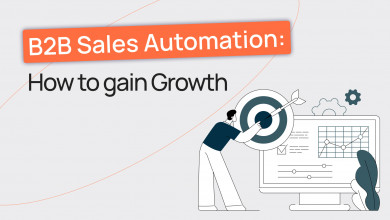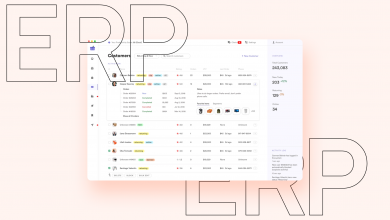Does your business need an ERP system? In 99% of cases, the answer is a clear YES!
Key signs that it should have been implemented "yesterday" or that you might need it as early as tomorrow:
- Your business handles large volumes of data, and the amount of information is constantly growing;
- You feel the need to increase process efficiency through automation;
- You've encountered issues with data inconsistencies (for example, different departments having conflicting information about inventory);
- You find it difficult to get a complete picture of your business's status in real-time, which slows down key decision-making processes.
You can say that many things "play a key role in ensuring efficiency and competitiveness," but in the case of ERP systems, it's truly the case.
The global market of ERP-systems across the entire was valued at $62.3 billion in 2023, and it's projected to reach $86.30 billion by 2027, with a compound annual growth rate (CAGR) of 9.4% from 2024 to 2032.

Let's take a detailed look at the key questions that will help you make the right decisions regarding B2B eCommerce ERP integration.
What is a ERP integration for eCommerce?
Enterprise Resource Planning (ERP) is software that integrates key business processes into a single system. In B2B companies, this often includes managing sales, inventory, procurement, finance, human resources, and other operations.
Accordingly, ERP solution integration is the process of connecting the ERP system to your eCommerce platform. It usually occurs in 4 stages:
- Needs Assessment: This involves identifying the processes that require automation and determining the scope of implementation.
- Vendor Selection: There are several well-known solutions to choose from, such as SAP S/4HANA, Oracle ERP Cloud (for large-scale operations); Microsoft Dynamics 365, Sage X3 (for mid-sized businesses); and Odoo, ERPNext (for smaller operations), often implemented by an experienced Odoo development company to ensure proper customization and scalability.
- Customization for Company Needs: This step involves selecting the optimal configurations and adapting the software to align with internal processes and your eCommerce website.
- Employee Training: This includes creating regulatory materials, conducting training sessions, and ensuring staff are well-prepared to use the new system effectively.
Each of these stages may seem straightforward at first glance, but they require in-depth analysis and careful planning. For example, if you miscalculate your needs and overlook the scalability of the system, you might later face a lack of functionality to support an increased number of processes. The solution? You'll end up having to replace either your B2B eCommerce platform or ERP system.
Vendor selection is critically important because not all ERP systems offer "out-of-the-box" eCommerce integration. It's essential to ensure that the solution you choose, even if it meets other criteria, will integrate easily without relying on workarounds or "hacks."
In addition, there are several other ERP integration challenges, which we'll discuss later. For now, let's focus on a more positive aspect — the benefits that a B2B business can reap, provided all the preparatory steps are successfully completed.
The top benefits of integrating the commerce engine with the ERP system(s) for B2B companies
In this case, the implementation of innovations will be more noticeable to your employees than to your B2B customers. From a global perspective, your customers don’t really care how you provide them with up-to-date product data/descriptions, pricing, or availability, nor how you generate invoices (whether automatically or manually). What they expect is an outstanding customer experience.

For your employees, however, the integration of B2B eCommerce and ERP is a significant step to:
- Increase throughput: Handle more orders efficiently without overloading the team.
- Reduce order and delivery errors: Ensure accurate data flow across systems, minimizing costly mistakes.
- Eliminate routine tasks: Automate invoicing, inventory checks, and other repetitive tasks, allowing employees to focus on more strategically important issues.
Managers, in turn, gain the ability to monitor performance more effectively by generating reports on sales across products, sales reps, regions, and other critical metrics.
Holistic inventory management
One of the most valuable advantages is the ability to respond quickly to emerging crises:
- Sudden spikes in demand;
- Order processing issues due to data errors (such as out-of-stock items);
- Losses from overdue payments and insufficient inventory levels, etc.
You can automate purchase requests when inventory reaches a minimum threshold. Moreover, modern smart ERP systems with integrated machine learning and analytics features can assist in forecasting downturns and prevent overstocking (as well as prolonged storage costs).
In any case, you'll have a powerful tool at your disposal, providing Real-time data on inventory levels. This will simplify management and enable more informed strategic decision-making, allowing you to stay agile and competitive in dynamic market conditions.
Streamlined business processes
B2B eCommerce processes are much longer and more complex than those in the B2C space, yet customer expectations remain the same. They want omnichannel experiences, fast order processing, prompt delivery, and no obstacles along the way. Customers expect to know the status of their order at any given moment and to have 24/7 access to their purchase history.
When data from the ERP system is integrated with eCommerce, marketing efforts become more targeted and successful. For example, you can increase profits by offering special terms for your most valuable customers. You can also set up automatic notifications for shipment dispatch and online tracking of deliveries. This will positively impact customer satisfaction and serve as a foundation for building a positive brand reputation.
However, streamlined business processes extend beyond customer interactions. They also encompass automation in various areas, including:
- Generating accounting entries based on sales and purchase transactions;
- Creating income and expense reports;
- Calculating employee salaries considering hours worked and taxes;
- Managing logistics operations, and more.
You can optimize virtually anything, thereby addressing even the most unconventional business challenges. For instance, a custom-developed ERP system could include a "Demand Forecasting" feature that automatically analyzes customer behavior and predicts which products or services they will need in the future.
Data accuracy and control
Data reliability and consolidation with business processes are especially important for B2B companies in the following contexts:
- Making sound strategic decisions;
- Efficiently managing supply chains;
- Ensuring the accuracy of financial accounting and reporting;
- Reducing risks and ensuring compliance with standards;
- Improving customer interactions.
Working with large contracts, lengthy supply chains, and complex processes is not possible without accurate and up-to-date data. Their consolidation with business processes forms the foundation of efficiency and resilience. This allows businesses to minimize errors, respond swiftly to changes, and make informed, well-grounded decisions, which is particularly crucial in the competitive environment of the B2B market.
Increasing Revenue and Reducing Operational Costs
eCommerce ERP integration is an excellent way to address performance issues. Yes, combining these systems may still seem like a substantial project. However, this is nothing compared to the tedious data synchronization and the burden associated with manual data entry. Moreover, having redundant software often leads to costly errors.
By freeing up resources to focus on customer acquisition, strengthening business relationships, building a unique brand, developing new products, and enhancing the user experience, you will achieve sales growth and increased profitability.
B2B eCommerce ERP integration challenges to watch
One of the key challenges you may face is the complexity of technical integration with outdated systems and platforms. Sometimes these systems simply lack the functionality or capacity to handle real-time synchronization, maintain process seamlessness, and ensure efficient data flow.
To address this issue, you could consider custom coding (though this isn’t always feasible) or look for middleware solutions to bridge the gap. Alternatively, you might opt to replace your eCommerce platform with a new one, taking advantage of our recommendations.

Data Migration
Data from legacy systems may be inconsistent or contain errors, necessitating cleansing and normalization before migration. Additionally, transferring large volumes of data can be time-consuming and require significant computing resources. It's also important to remember that different systems may use various data structures and formats, which will necessitate extra work for data transformation.
Security and compliance requirements
Any transformation is a moment of potential vulnerability, especially when it involves access to sensitive business information and customer data (which you expose to third-party service providers) during B2B ERP integration. Ensure that secure transmission protocols are used throughout the process, implement stringent access controls, and conduct regular audits.
Process Configuration
This encompasses all aspects related to the deployment of new software, including:
- Development of Integration Modules
- Customization Needs
- Multi-layered Testing
- Technical Support
If your company has its own IT specialists, they can study and configure the ERP system, particularly when it comes to popular platform like Odoo. In other cases, outsourcing specialists may be necessary, which can often be more cost-effective than retraining existing employees and incurring training expenses.
Three ways to integrate your B2B ecommerce and ERP platform
Choosing the right type of ERP software depends on the specific needs of the business, its size, industry, budget, and strategic goals. One of the main differences between systems lies in the deployment method.
On-premise
Installed and maintained on the company's own servers.
You get:
- Full control over data and the system;
- The ability for deep customization.
Disadvantages: High initial costs and the need for in-house IT personnel for maintenance.
Cloud
Access to the system is provided via the internet, and maintenance is handled by the provider.
Advantages:
- Lower initial costs;
- Quick implementation;
- Automatic updates.
Disadvantages:
Limitations in customization. If there are issues with the internet connection, all business processes come to a halt.
Hybrid
They combine the best features of on-premise and cloud deployment. These systems are the most complex in terms of integration and management. However, they offer flexibility in choosing components for deployment and the possibility of a gradual transition to the cloud.
Additionally, systems may vary by industry specificity and functionality (comprehensive/module/specialized, focusing on specific business processes).
Understanding all this, you can choose the optimal path for eCommerce integration with ERP:
- API (Application Programming Interface): One of the most popular and flexible methods of integration. It provides a set of functions through which one system can request and send data to another system. This can happen by default (constantly, in real-time), on a schedule, or through a manual command.
- Middleware: This is software that connects various systems and applications, ensuring their interaction. It can handle requests between systems, perform data transformations, manage security, and control data flows.
- ESB (Enterprise Service Bus): This is an integration platform that manages interactions between different systems within a company through a single communication channel. ESB is often used to integrate many different systems without requiring direct connections between each pair of systems.
Of course, there are other options that can be applied based on specific business needs. However, we believe these three are the most popular, flexible, and effective.
Conclusion: Which ERP System is Right for Your Business?
The one that aligns with the unique processes and specific requirements of your business, ideally without the need to conform to standard templates. It should be flexible and scalable, easy to integrate, and cost-effective in the long term. Additionally, it should ensure high data security.
Does such a solution exist in reality? Yes.
However, this is definitely not about ready-made solutions that offer a standard set of features. We're talking about a custom ERP developed from scratch specifically for your business processes. This is particularly relevant if your business has a unique pricing structure or specific approval stages for transactions: a custom system will accommodate these needs without the need to "reinvent the wheel" or make inconvenient compromises.
This is not just an automation tool; it's a strategic asset that will help the company operate faster, more efficiently, and securely. It represents a valuable competitive advantage. You receive not just a "one-size-fits-all" solution, but a system that perfectly fits your operational model, is scalable, and provides complete transparency and control over the business. Would you like to discuss the option of such a development?


